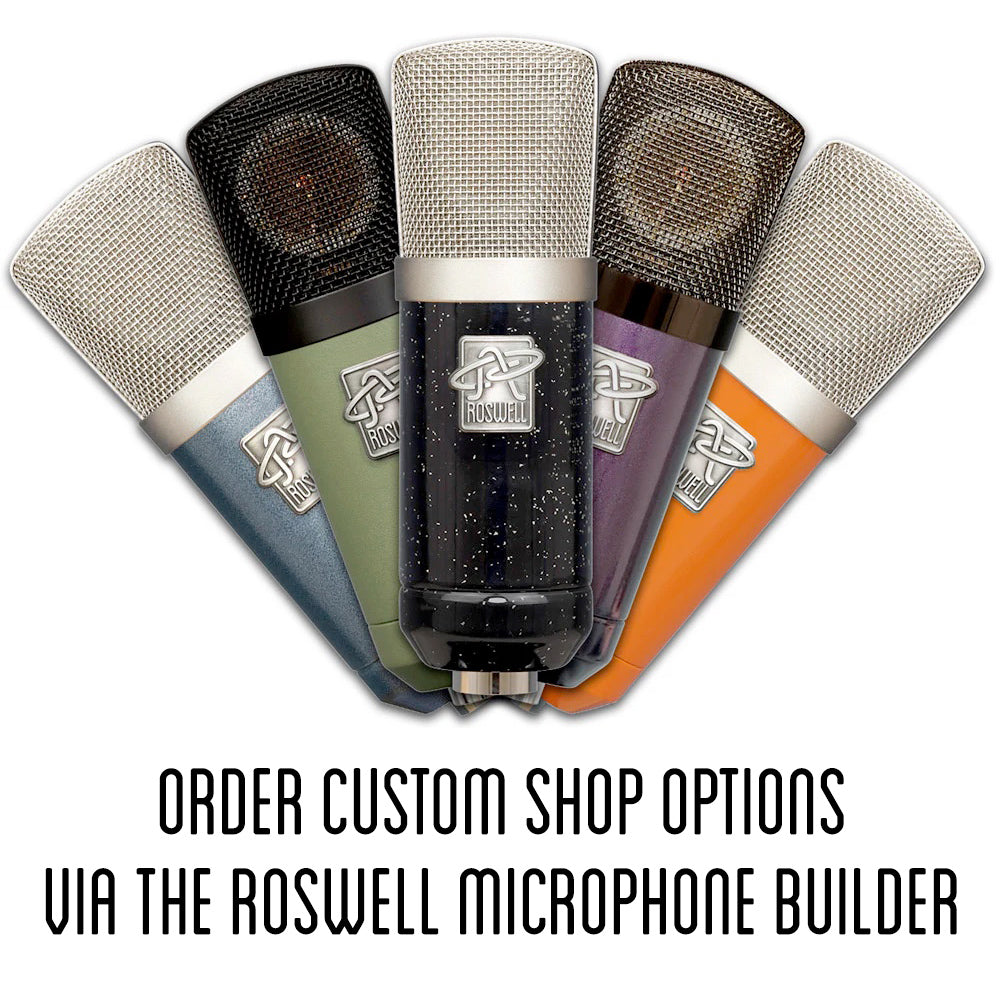"The Roswell Cab Mic has become one of my go-to mics for electric guitar. The smooth top end and robust lows make the mic easy to dial in. I can place the mic in the center of the cone without any harshness. I never feel the need to add another mic to balance missing frequencies; just move this mic around the cone a bit to get the tone I want without any phase issues from a second mic. Highly recommended!"
- David Grissom
Overview
- Voiced like a ribbon mic
- Never harsh, never too bright
- Purpose-built for electric guitar
- Captures your tone with minimal effort
Origin Story
David Grissom and Tim Pierce had been testing the RM8 mic on cab. Both loved the tone. Neither needed the RM8's internal pattern circuitry. I commented to David that I could design a simpler, purpose-built mic for guitar cab, to recreate the tone he loved in the RM8, but make it easier to use and more accessible for guitarists. He liked the idea. (That's why I put his initials on the circuit board.)
Guitar cabs represent a fairly unique application. They can be loud, so the mic would need huge amounts of headroom. The mic should have a soft top end, to eliminate harshness. The mic should work well on its own, so that artists need not manage comb filtering (phase cancellations) invariably created when two or more mics are put on the speaker.
We designed a low-distortion circuit and a large-diaphragm capsule with a unique tuning. We implemented the circuit with fantastic components. The combination has beaten numerous popular mics on guitar cab, including dynamics, condensers, and ribbons.
Custom Shop
Click here to customize / personalize your Cab Mic via the Roswell Mic Builder.
Included Accessories
The Cab Mic ships with a heavy duty swivel mount and a mic sock.
In our testing, shockmounts do not seem necessary for recording guitar cab; the cab is louder than (and causing more vibration than) foot or vehicle traffic, or whatever other ambient vibrations you would normally want to isolate.
If you prefer to buy the Cab Mic with a flight case and shockmount, you can order that configuration via the Custom Shop.
How To Use The Cab Mic
 Most guitarists will tell you to never aim a microphone at the center of the dust cap. It's true that that position is too bright and too harsh for common dynamic mics. But as Steve Albini pointed out many years ago, the center of the speaker is the location with the least smearing, the least filtering, the least distortion, the most clarity, and the most articulation. That's where he usually miked a cab. It's impossible to argue with his results (e.g. Nirvana).
Most guitarists will tell you to never aim a microphone at the center of the dust cap. It's true that that position is too bright and too harsh for common dynamic mics. But as Steve Albini pointed out many years ago, the center of the speaker is the location with the least smearing, the least filtering, the least distortion, the most clarity, and the most articulation. That's where he usually miked a cab. It's impossible to argue with his results (e.g. Nirvana).
The trick is to use a microphone that works well in that location. Albini seemed to prefer vintage RCA ribbon mics. Those sound great if you have a $4000 budget. The Roswell Cab mic works beautifully in the same position, at a slightly lower cost.
Start with the mic's grille centered on the dust cap of the speaker. Stand the mic with six inches of space between the mic grille and the speaker cloth. Crank up the amp's master volume to whatever that amp's sweet spot is; the mic can take whatever level you give it, and it won't overload the preamp.
To increase bass content, move the mic closer. To decrease bass content, move the mic back. The Cab Mic has good proximity effect -- more linear and more predictable than a ribbon mic (read that as "less likely to get muddy").
Features
- Custom large-diaphragm capsule, proprietary tuning
- High-headroom, low-distortion circuit design
- Hand-picked, audiophile-grade circuit components
- Heavy, solid steel body
Benefits
- Unique voicing makes it easy to capture the tone of your amp.
- The mic's gain staging accommodates 100W tube amps, without clipping your preamp or converters.
- Solid, high-quality construction ensures real-world durability and long service life.
Comparing the Cab Mic to other Mini K microphones
Most of the "Mini K" mics can be used on guitar cabs. They can work beautifully in that application -- e.g. the band Little Feat has used the Mini K67x on two cabs on stage for the past three years. (Scott Sharrard's Two Rock rig is so loud they put it behind a plexiglass shield to prevent it from competing with the main PA.)
The Cab Mic has lower sensitivity, lower output, and more headroom than all of those models. It also has a darker voicing than all of them.
In terms of the mic's internals, the Cab Mic uses a different capsule from the rest of the mics. The circuit has a similar topology to the KD, but the circuit is tuned differently and uses different components in critical locations (because we optimize every mic we build for its intended applications).
Comparing the Cab Mic to Ribbon mics
As noted previously, the Cab Mic's voicing is similar to ribbon mics, primarily in its frequency response above 1kHz. The Cab Mic's response rolls off gently above 3kHz, which prevents guitar cabs from sounding harsh.
The Cab Mic has a nominally Cardioid polar pattern, which gives it more-linear and more predictable proximity effect than any Figure-8 ribbon. (For the purists: the Cab Mic's polar pattern is slightly narrower than textbook Cardioid; this helps give the mic its punchy sound.)
The Cab Mic is not fragile in the way that ribbon mics are. A puff of air on the capsule will not break the Cab Mic.
Tech Data
| Model: |
Cab Mic |
| Acoustic Principle: |
Pressure gradient transducer |
| Polar Pattern: |
Cardioid |
| Capsule: |
34mm O.D. True Condenser
|
| Sensitivity: |
4 mV/Pa
|
| Impedance: |
112 Ohms |
| Signal-to-noise: |
83 dBA |
| Equivalent noise: |
11 dBA |
| Supply voltage: |
48±4 VDC |
| Output: |
Electronically balanced |
| Physical dimensions: |
150 × 44mm; 380g (mic only) |







 Most guitarists will tell you to never aim a microphone at the center of the dust cap. It's true that that position is too bright and too harsh for common dynamic mics. But as Steve Albini pointed out many years ago, the center of the speaker is the location with the least smearing, the least filtering, the least distortion, the most clarity, and the most articulation. That's where he usually miked a cab. It's impossible to argue with his results (e.g. Nirvana).
Most guitarists will tell you to never aim a microphone at the center of the dust cap. It's true that that position is too bright and too harsh for common dynamic mics. But as Steve Albini pointed out many years ago, the center of the speaker is the location with the least smearing, the least filtering, the least distortion, the most clarity, and the most articulation. That's where he usually miked a cab. It's impossible to argue with his results (e.g. Nirvana).








